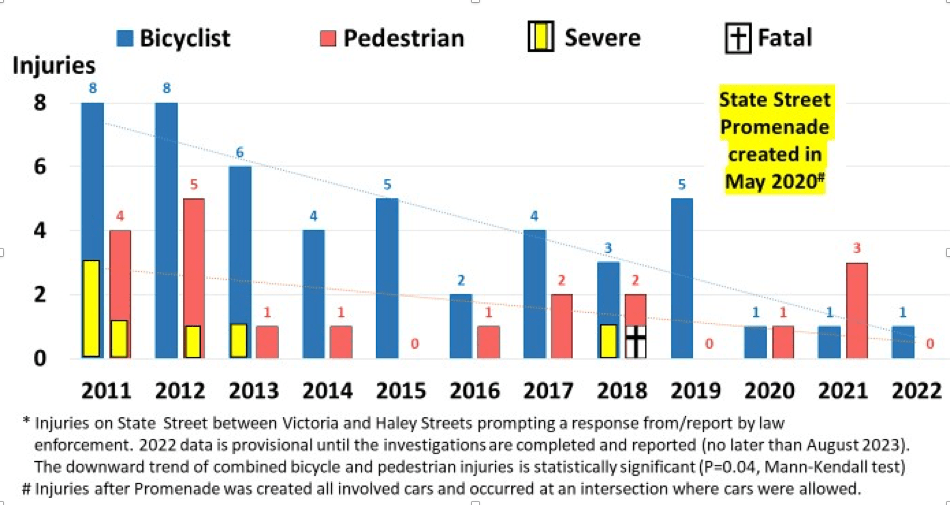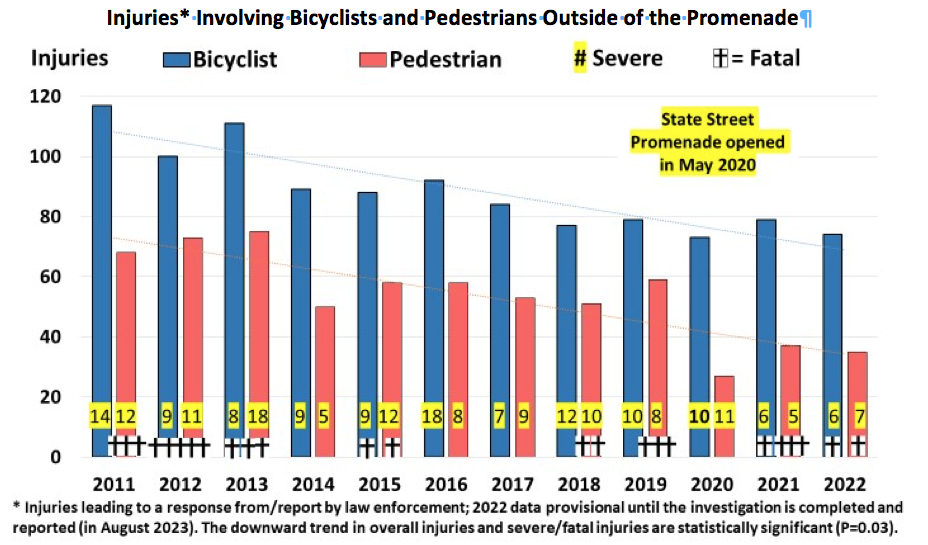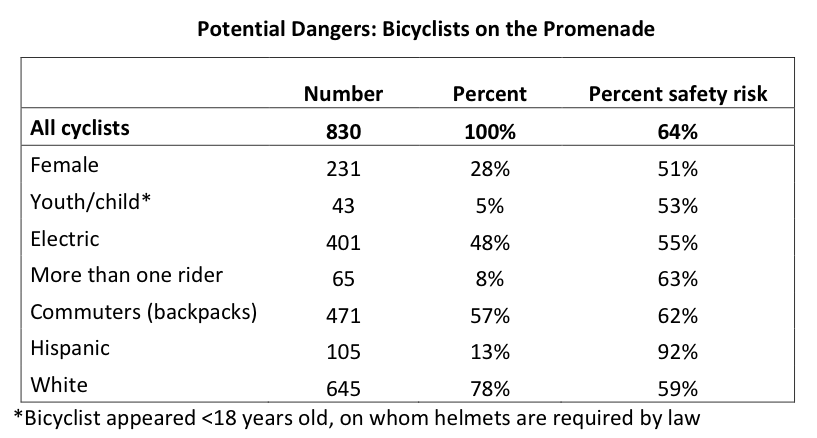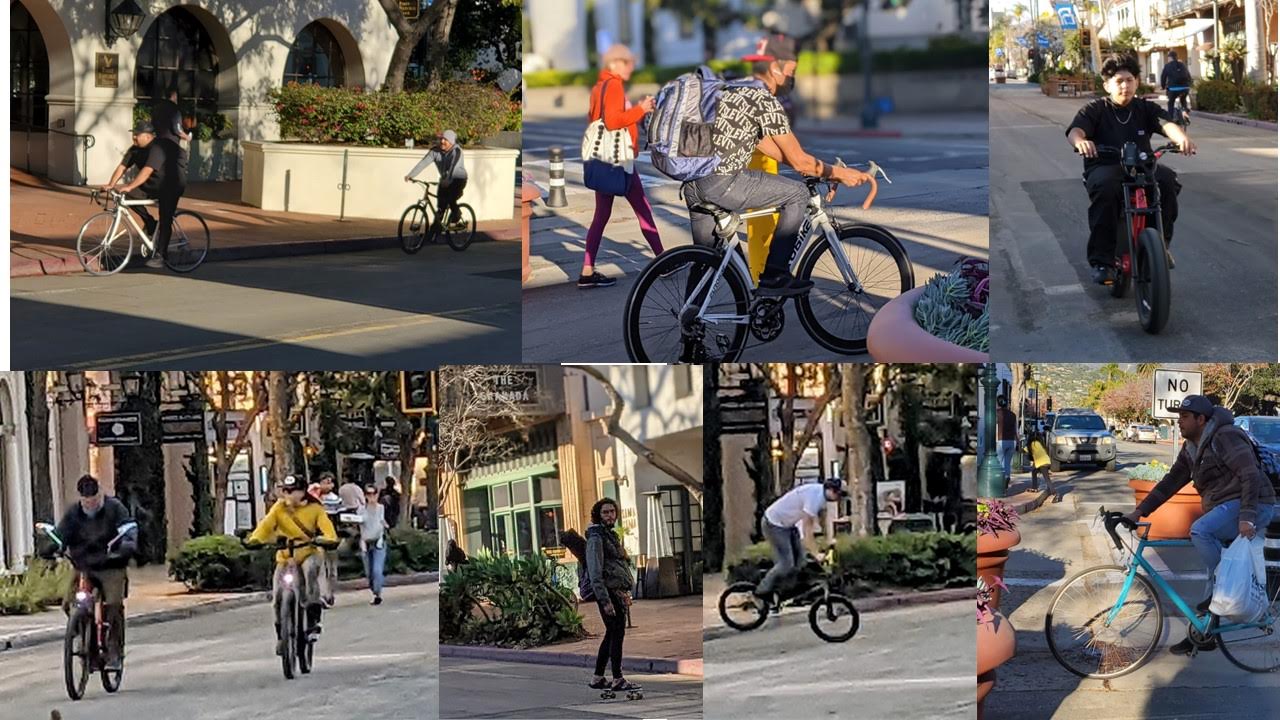No one venturing onto the part of State Street closed to cars, known as the Promenade, could miss the surge in pedestrians and bicycles (especially e-bikes), skateboards, and even unicycles — weaving around and through each other, evoking fear, fury, nonchalance, amusement, or joy.
While perceived risk can’t be ignored, data shows that, despite the surge in electric bikes, the Promenade space is much safer than before it was created, so safe that it probably can’t get much safer. In contrast, severe injuries and deaths of bicyclists and pedestrians continue to occur elsewhere in the city.
On the Promenade
Despite a surge in e-bikes and emotions, severe and fatal bicycle and pedestrian injuries on the Promenade have decreased significantly since it was created in 2020.
Injuries of Bicyclists or Pedestrians Before and After the Creation of the Promenade*

Off the Promenade
Elsewhere in the city, severe bicycle and pedestrian injuries have also decreased to the point that the city has met its Bicycle Master Plan injury reduction objective (fewer than 82 per year). Unfortunately, law enforcement reports do not distinguish between electric and conventional bicycles, so the only data on e-bikes come from Santa Barbara BCycle: Only two riders were injured in over 800,000 miles traveled.

Potential Injuries
To determine why there is so much concern about bicyclists on the Promenade, we conducted observations of risky behaviors on four Tuesday afternoons in late 2022. We calculated the percentage of bicyclists not wearing helmets, riding without hands, using cellphones, and having baggage dangling from handlebars (below), as well as their other characteristics.
No actual collisions were seen, but risky behavior was observed in almost two-thirds of riders, most commonly lack of helmets (62%). Excess speed, cell phone use, riding without hands, and tricks such as wheelies were less frequent. Of the 43 youth/children, a risk was observed in more than half.
More than two-thirds of Hispanic riders appeared to be commuting; 92 percent were not wearing helmets.

Why have severe and fatal bicycle injuries been eliminated on the Promenade while potential risks abound? Not surprisingly, eliminating cars and trucks has created a much safer environment for cyclists and pedestrians, who seem to coexist serious-injury-free despite the apparent chaos…so far.
In addition, bicycling – even risky bicycling – may not be as dangerous as some believe. It is also important to consider the behavior of pedestrians in a mixed-use setting, sometimes erratic and unpredictable, complicated by pets and baby strollers.
More Important Problems
Santa Barbara’s Vision Zero strategy focuses on eliminating fatal and severe injuries by 2030. By this metric, the Promenade is a success. However, the real challenge lies outside the Promenade, where the number of bicyclist and pedestrian deaths has changed little over time.
Even this data is probably incomplete because elsewhere in the United States, between one-eighth and one-half of bicycle and pedestrian injuries are not reported to law enforcement. In Carlsbad, a collaboration allowed the city to obtain complete data on e-bike collisions, declare a State of Emergency, and secure funds to increase education and change bicycle laws and their enforcement. In Boston, collaboration with hospitals and public health departments was essential to showing that its expansion of bicycle paths prevented deaths and injuries.
We need more collaboration to determine if Santa Barbara is meeting its Vision Zero objectives. Cyclists involved with any accident involving injury, crime, or unsafe behavior injury or should first call 911 to determine if medical or law enforcement response is needed and ensure the inclusion of the accident in the data reported here. A partnership with Cottage Hospital could determine the number of and circumstances surrounding severe and fatal injuries not reported to law enforcement.
Cyclists involved with any incident, including near misses, and road hazards, are encouraged to help by reporting to bikemaps.org.
A large part of the problem is a national one. Being a pedestrian or a cyclist in the U.S. is much more dangerous than in other similarly developed countries. This is because we don’t have a culture where pedestrians, cyclists, motorcycles, and automobiles can peacefully share crowded spaces as they do in other parts of the world.
Prevention of injuries and deaths will require better data, more bikeways without cars, non-punitive enforcement of regulations and helmet laws, and recognition that electric bikes are safe, albeit sometimes annoying.
Dan Fishbein is a medical epidemiologist and public health physician; Steve Nelson is vice-president of Echelon Cycling Club Santa Barbara; and Nathan Burns-Sprung is education and encouragement coordinator for MOVE Santa Barbara County.





You must be logged in to post a comment.